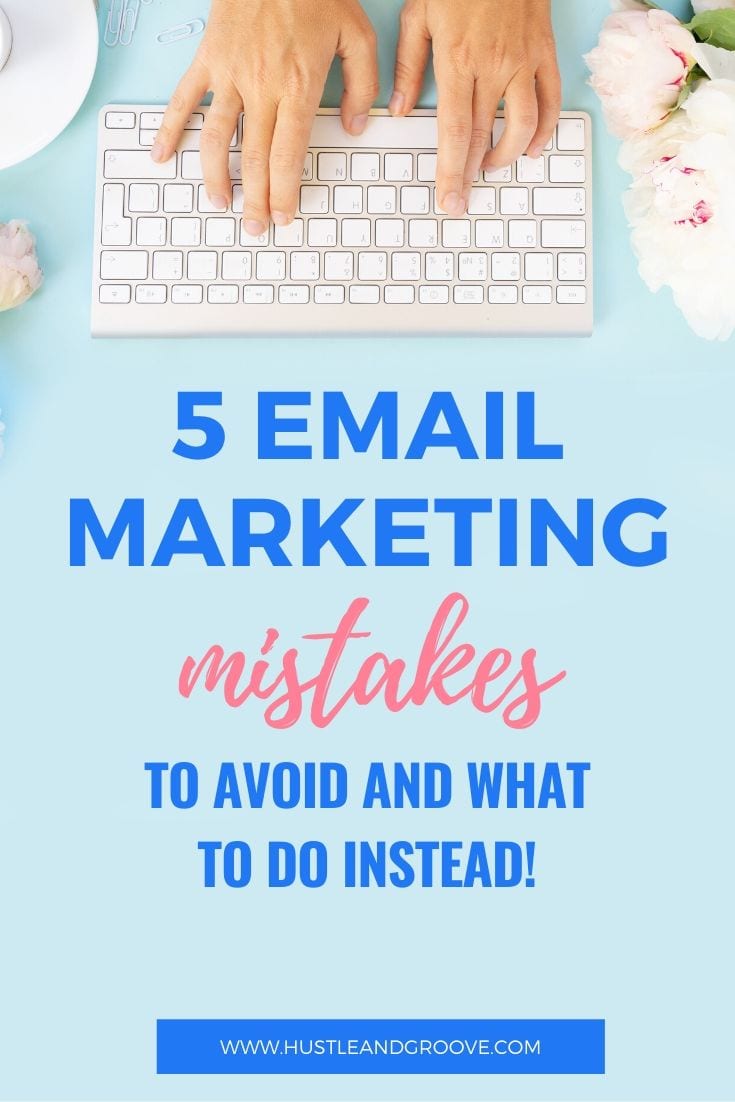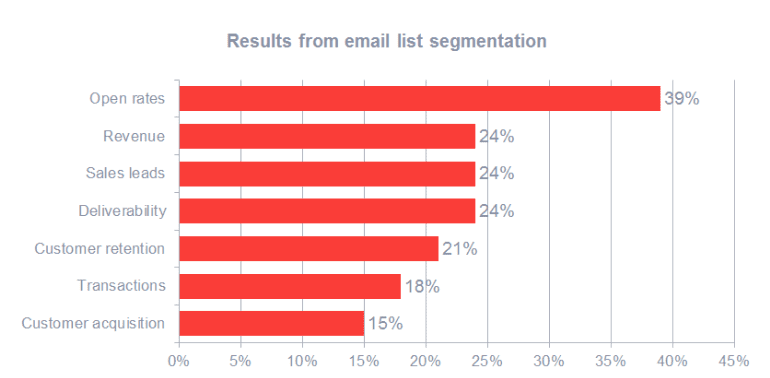Email marketing mistakes are something you want to avoid as much as possible.
While there are many new technologies that come and go, email communication shows no signs of slowing down.
In fact, the number of global email users is expected to soon surpass 4 billion.
Although email marketing is extremely popular, millions of people are doing it wrong and making a lot of costly mistakes.
We are here to make sure that, whether you’re now getting started with email strategy or you’re a more seasoned sender, you’re not making any of the following email mistakes.
Let’s dive right in.
Image Source: Oberlo
Table of Contents
Top 5 Email Marketing Mistakes to Avoid
#1: Not prioritizing sign ups
Your messages may be amazing, timely, transcendental even. However, if you want to see results, you need to have a promising list of email addresses you can send your messages to.
How do you build this list?
By prioritizing sign-ups.
The best way to get your customers to sign up is by showing them that there is something to be gained by subscribing.
In the case of eCommerce businesses, discounts can be used in exchange for sign-ups.
Offerings like free downloads, video tutorials, or other types of exclusive content are also great for wrangling up more email opt-ins, regardless of your business model.
Keep in mind that people are much more willing to subscribe and share their email when there’s some sort of added value attached.
Think carefully about your target audience and tailor your offerings to suit their needs.
Check out this how-to guide which provides some concrete email marketing list building strategies. It covers everything from recommended platforms to personalized landing pages.
And also check out Lise's book, Capture, Convert, Captivate, for a more in-depth look at email strategizing.
#2: Not optimizing welcome emails
You never get a second chance to make a first impression.
So now that your hard work of pushing for sign-ups has paid off and some prospective customers just subscribed, your next move is key.
Far too many new email marketing users blow this opportunity.
But you’re not like the others. You will seize this chance and blow them away with your welcome email sequence.
Be sure to introduce them to your business in a timely manner while setting a great tone for all emails to come.
According to Experian Marketing Services, welcome emails generate 320% more revenue than other marketing messages. They also have a 336% higher transaction rate and a 196% higher click-through rate than any other email messages.
These numbers are no joke, so you have to take the challenge of optimizing your welcome emails very seriously.
The infographic below does a stellar job at outlining how best to structure your ‘thank you for subscribing' message.
In addition to considerations like subject lines and ‘from’ emails, this insightful guide provides great advice on how to craft catchy welcome emails. Do yourself a favor and soak it all in.
#3: Not optimizing for mobile
There are now more than 3.937 billion global mobile internet users as of July 2019. In the first quarter of 2019, mobile internet traffic made up more than 40% of all internet traffic. Those numbers are staggering and bring home a very important point: the message you craft on your desktop computer will inevitably be displayed on a customer’s mobile device.
If your message is not optimized for a mobile device, your email will be rendered useless. In fact, as reported by Adestra, almost 75% of persons will delete an email that doesn't display correctly on their mobile. As many as 15% of users will even unsubscribe, instead of deleting the email.
Some of the things that qualify as poor formatting for mobile emails include poorly sized or placed images, an insufficient amount of breaks between texts, and having a multi-column layout without a responsive template.
A great way to combat this is to use a responsive template that has been tested and that you are sure actually works.
Here are 35 free examples you can consider trying out.
Always send test emails to yourself first and check them on your smartphone and tablet.
Only when the formatting works on different devices should you go ahead and send out to customers.
Here are 6 additional actionable tips you should keep in mind before hitting send on your mobile phone destined emails.
#4: Avoiding customer segmentation
When dealing with email marketing, segmentation simply means sending different emails to different groups of customers.
Emails can be segmented by 4 main criteria:
- demographic,
- behavioral,
- geographic;
- and psychographic.
You can screen for interests, age, technology preferences, hobbies and the list goes on and on. The only limits to segmentation lie in your imagination and the nature of the data you have on contacts.
For most online business owners, you'll mainly segment by location, interest (aka tags you set up within your email platform), and purchase history.
It’s now common knowledge that marketers who segment their email lists and send personalized messages can dramatically improve conversion rates.
However, it’s still estimated that 70% of brands are failing to do so.
Are you among that 70%?
Well, even if you are, you don’t have to be.
By carefully considering the messages you send and finding creative ways to make them feel more personal, you tap into one of the most cost-effective methods for getting more out of your email marketing strategy.
Your segmentation can be done right at the subscription stage, whereby subscribers are asked to select the topics they’re interested in.
This can then funnel them into targeted funnels that lead to your paid products or services.
However, if you want to reduce the barriers for willingness to sign up, you can wait until after you’ve received their contact information to ask further questions and send surveys to assist with your segmentation.
Image Source: SuperOffice
Segmentation can be basic or super complex. You need to figure out what works best for your business.
The bottom line is: the more engaged the customer, the better your email metrics will be, as clearly shown in the charted numbers above.
Based on the nature of your business and the needs of your individual subscribers, you should get to work on crafting a relevant strategy for target groups.
One-size-fits-all emails are fast becoming a thing of the past. Don’t let the same be said for your business.
#5: Not coming across as professional
Remember that everything you do has a direct effect on your image and credibility. The last thing that you would want is to come across as unprofessional to your audiences.
Start with the basics and be sure to proofread your emails before you hit send.
Ensure that your spelling, grammar and punctuation are all up to scratch. Feel free to rely on any of the great apps that assist with these kinds of email mistakes (like Grammarly), but be sure to actually read your marketing message to make sure it makes logical sense.
Chances are, a sentence may be grammatically correct but might actually make little sense.
It’s a good idea to do a cold-eyes review — meaning let it sit for a bit so you're more likely to spot any errors.
When you’re too familiar with a project your eyes tend to fill in the blanks.
Sure, it’s important not to delay marketing campaigns too much. But with that said, emails shouldn’t be sent in a matter of minutes either.
Take the same approach that you would if you publishing a blog post or adding a new landing page to your website.
Your Next Steps
Plan it out. Create an outline. Write the copy. Put it through some editing software. Proofread, and then proofread it again. Slang, spelling errors, and improper formatting will not reflect well on your business.
Imagine getting an email from a high-end brand trying to sell you a $2,500 watch. But the message is filled with typos and mistakes.
R U srsly gonna by dat watch?
Probably not. It looks like a poor reflection of that company as a whole.
People might wonder that if you don’t take the time to do something as simple as composing an email, what other shortcuts are you taking?
The ‘reply to’ address for all business emails should also link back to your business. Using a personal @gmail.com address costs you credibility. As will including contradictions, inaccuracies and downright falsehoods.
Research the material you are about to send.
Never quote random statistics from unreliable websites banking on people not checking. Don't make up data. Don't lie to your customers. Also, be sure that your current and future emails don’t contradict your past ones.
All in all…
A lot of marketing effort is left up to trial and error. Your email strategy requires careful thought about what each email is intended to do. But it’ll take quite a bit of fine-tuning and flopping before you get it just right.
Learning from your errors and the errors of others can save you a lot of grief in the long run. So for the love of all that’s holy, please take my advice and circumvent the above-outlined email marketing mistakes as much as possible.
Email marketing is an extremely effective way to connect with target audiences. Don’t squander it!
[img_text_aside style=”2″ image=”https://hustleandgroove.com/storage/2019/12/Uwe-Dreissigacker-Author_Bio-Photo-256×300.jpg” image_alignment=”left” headline=”Uwe%20Dreissigacker%20%7C%20InvoiceBerry” alignment=”left”]”Uwe Dreissigacker is the founder of online invoicing software InvoiceBerry also offers free invoice templates to businesses. Small businesses and sole traders can create, send and manage their invoices, quotes and credit notes with the tool. In his free time, Uwe travels the world and enjoys experiencing different cultures.”
[/img_text_aside]


2 replies to "Top 5 Email Marketing Mistakes to Avoid"
Good article.
Thank you.
You’re welcome Doug!